Campanula uniflora L.
Arctic harebell (Arctic bellflower)
Campanulaceae (Bellflower family)
Introduction to Vascular Plants
Arctic harebell (Arctic bellflower)
Campanulaceae (Bellflower family)
Introduction to Vascular Plants
Species Information
General:
Perennial herb from a taproot and slenderly branched stem-base or rhizome; stems several, lax, 3-30 cm tall, glabrous except for a few long, loose hairs.
Leaves:
Basal leaves oblanceolate or wider, stalked; stem leaves alternate, sharply toothed, elliptic to oblanceolate or linear, 0.5-4.5 cm long, 0.1-0.7 cm wide, becoming stalked above.
Flowers:
Inflorescence of solitary, erect, bell-shaped flowers; corollas 6-12 mm long, blue; corolla lobes erect to ascending, usually shorter than the tube; styles shorter than or equalling the corolla.
Fruits:
Capsules, 12-20 mm long, elongate, tapering to the base, opening near the summit.
Illustration

If more than one illustration is available for a species (e.g., separate illustrations were provided for two subspecies) then links to the separate images will be provided below. Note that individual subspecies or varietal illustrations are not always available.
Illustration Source: The Illustrated Flora of British Columbia
Ecology
Ecological Framework for Campanula uniflora
The table below shows the species-specific information calculated from
original data (BEC database) provided by the BC Ministry of Forests and Range.
(Updated August, 2013)
The table below shows the species-specific information calculated from
original data (BEC database) provided by the BC Ministry of Forests and Range.
(Updated August, 2013)
| Site Information |
Value / Class |
||
|
Avg |
Min |
Max |
|
| Elevation
(metres) |
1743 | 1460 | 2135 |
| Slope
Gradient (%) |
20 | 2 | 60 |
|
Aspect (degrees) |
210 | 2 | 360 |
| Soil
Moisture Regime (SMR) [0 - very xeric; 4 - mesic; 8 - hydric] |
2 | 1 | 5 |
| Modal
Nutrient Regime
Class |
B | ||
| #
of field plots species was recorded in: |
20 | ||
| Modal
BEC Zone Class |
BAFA | ||
|
All BEC Zones (# of stations/zone) species was recorded in |
BAFA(15), cma(1), ESSF(4) | ||
|
Source:
Klinkenberg 2013
|
|||